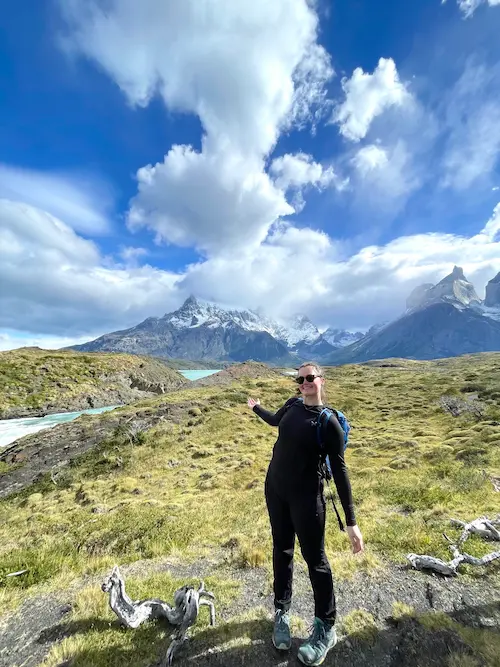
By: Kendi Borona, PhD
Sun, Surf, and Directed Research
Coming back from our mid-semester break, students leapt right in and started their Directed Research (DR) work. The DR capstone course improves students’ knowledge of the research process and helps students develop research skill sets such as understanding the process of designing a field research project, conducting data collection in the field, managing and analyzing data sets, communicating research results to a diverse audience, as well as team work and time management skills.

Lionfish team members – Neil Ferland, Julia Locke, Rob Price and Meredith Berube – doing a lionfish dissection. Photo courtesy of Ewa Krzyszczyk
DR work also contributes to our current understanding of socio-environmental issues that are relevant to the people of South Caicos, as well as the Turks and Caicos Islands (TCI) as a whole. At the end of the semester, the students’ work will contribute to a growing body of scientific research that informs local conservation and resource management decisions. For instance, one of my DR groups from last semester (Chloe Carothers, Isaac Fournier, Alissa Miller-Gonzalez and Andrew Staley) interviewed South Caicos residents about their feelings towards conservation and development projects on East Caicos, a currently uninhabited island just north of South Caicos. These students’ final reports are now being used by a local conservation group to inform their policy-making regarding the future of East Caicos. Data collected by my other DR group (Kellie Nordquist and Erika Roth) from last semester which investigated recreational ecosystem services is now being used by the national TCI government in a Natural Capital Accounting project, which will have implications for environmental policy-making nationwide. It is exciting to think about all the ways the research done by students this semester can significantly impact decision-making regarding the natural resources of the TCI.
This semester we have eight(!) DR projects investigating a wide variety of topics:
- Effects of sargassum blooms on seagrass beds
- Coral reef accretion, topographic complexity and calcium carbonate budgeting
- Lionfish population assessments
- Behaviors in ocean surgeonfish with black spot disease
- Fish species and abundance in mangroves
- Stony Coral Tissue Loss Disease and coral bleaching
- Conch behavior in relation to fresh knocked conch, as well as fishermen perspectives of the ‘conch midden myth’
- Cultural ecosystem services
So far, we have had one ‘dry-run’ DR day (or perhaps more accurately, ‘wet-run’) which was used for practice and setting up equipment, and one full day of data collection. We have 10 more days of data collection ahead of us, and we are staying optimistic that we’ll have excellent weather and continued success with each project. I have asked my fellow faculty members to help give brief updates from each of our DR groups below.
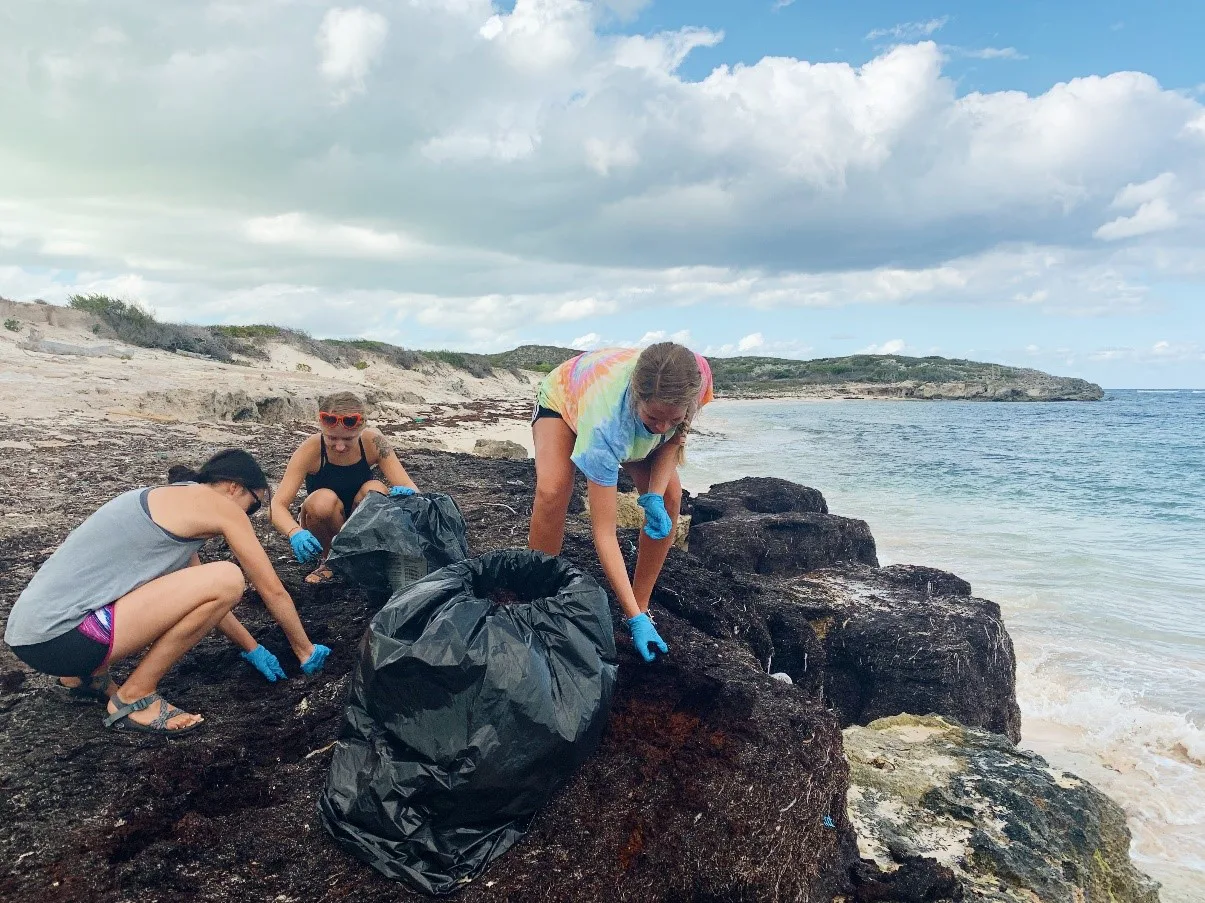
Sargassum team members – Sophia Troeh, Sabrina Koetter and Sarah Shadle – harvesting sargassum. Photo courtesy of Sam Hudgens
Sassy Sargassum started their DR with rather wet dry runs in the swim zone to practice poking holes in seagrass shoots and tagging them with a zip tie: all in one breath of air. They also collected buckets full of sargassum that has been breaking down on the beach. On Monday was the big installation day. The day started by crafting chicken mesh walls to enclose broken down sargassum in 0.5 x 0.5 m plots. Twenty of these were then installed at East Bay and the seagrass shoots inside were counted and five of them were poked to measure growth in 3 weeks time. Then broken down sargassum was added to ten of the treatments: imagine a brown cloud of smelly stuff erupting out of a big trash bag! Once the cloud settled there was a few cm thick layer of broken down sargassum on the seagrass, much like what was seen in the field last Fall when sargassum loads were high on the beaches. [courtesy of Fran Elmer]
The Carbonate Compadres got off on a good start this week. After being pestered by their DR faculty during dry runs on Friday, they had a successful first day of data collection. Maybe those data sheets being swept into the bushes by an invisible current really did help prepare them for the ocean. On Monday they measured corals and algae to determine how fast the reef grows by these organisms putting down calcium carbonate. They also counted urchins and measured the area of bioeroding sponges, the counterparts in this balance, who erode the calcium carbonate down. In the afternoon they filmed their first two 1x 10 m transects for 3D coral reef modelling. Since then the SFS laptops have been running hot aligning pictures and building 3D models. [courtesy of Fran Elmer]
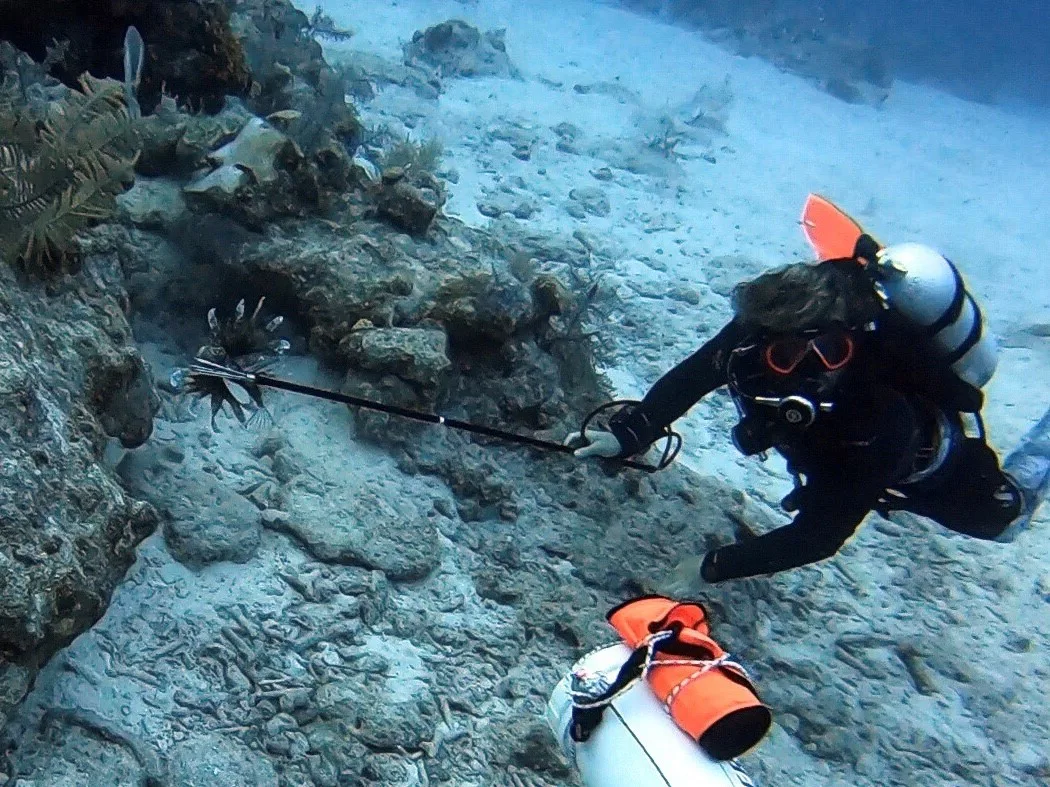
Dive Safety Officer, Nick Segel, spearing a lionfish with the lionfish DR group. Photo courtesy of Julia Locke
The Lionfish (Pterois volitans and P. miles), native to Indo-Pacific, have become established as voracious alien species that pose a serious threat to coral reefs in the Atlantic. The students are assessing the abundance of lionfish in South Caicos as well as asking if age and habitat choice are correlated and whether habitat choice influences predation habits, as well as if presence of divers affect the behavior of lionfish. [courtesy of Ewa Krzyszczyk] The team has gone diving to locate lionfish and have already done dissections to determine stomach contents.
Parasites can affect ecological outcomes and can play a role in the commercial value of fisheries and are therefore often utilized as bioindicators of pollution. A large proportion of coral reef fishes in the Caribbean have exhibited ‘black-spot syndrome’ (BSS), a condition characterized by conspicuous black spots on the fins and body. This study will use well known behavioral techniques to quantify ocean surgeonfish (Acanthurus bahianus) behavior. The students are testing for differences in behavior of ocean surgeonfish with and without visible infections of black spot that could make them more easily predated on by its osprey host. [courtesy of Ewa Krzyszczyk] Students recently spent an afternoon in the swim zone learning how to categorize fish behaviors and figure out underwater team dynamics.
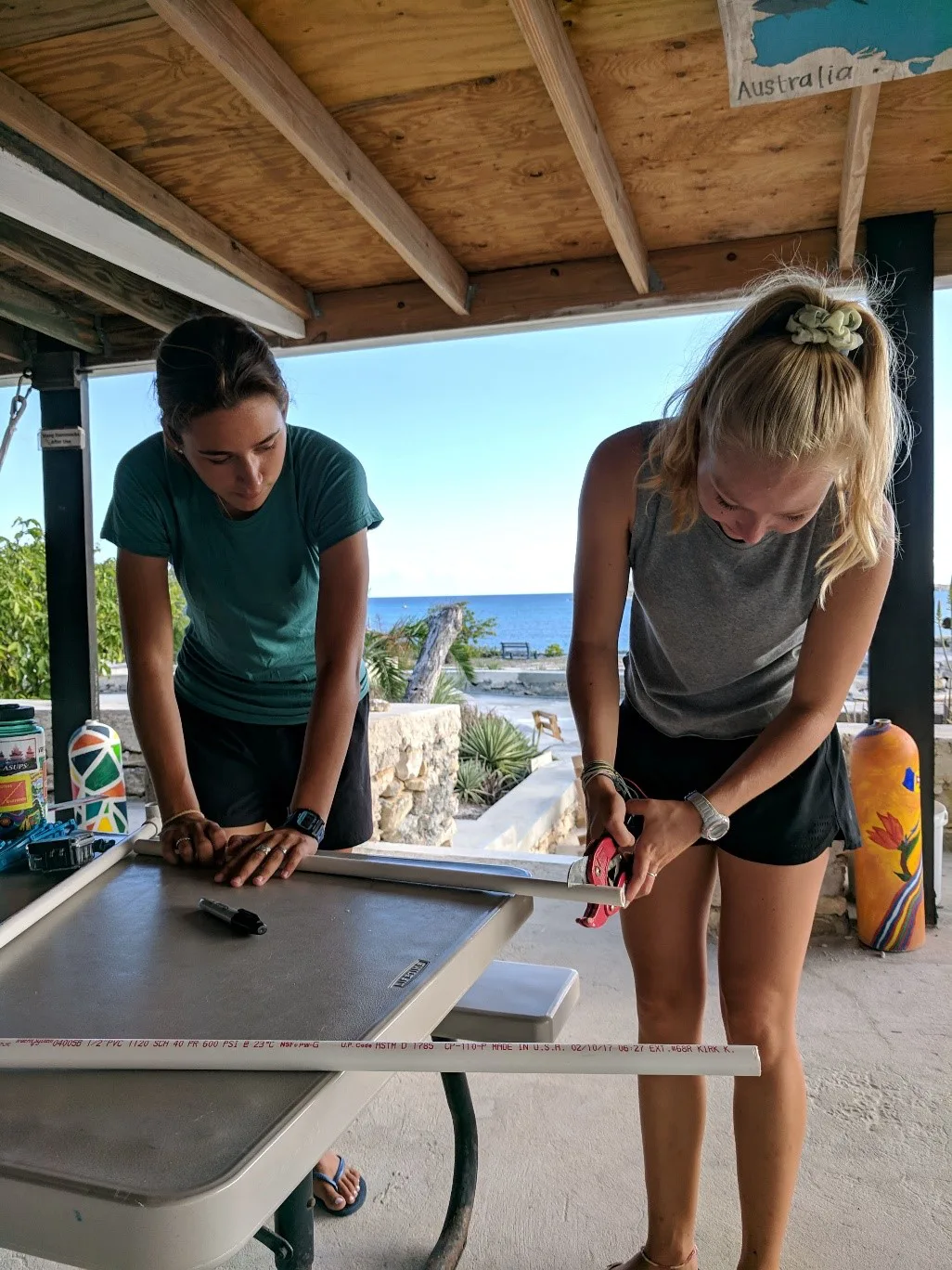
Mangrove team members, Jackie Fahrenholz and Megan Cassetty, building a BRUV (baited remote underwater video. Photo courtesy of Ewa Krzyszczyk
Mangrove forests are extremely productive ecosystems that provide numerous goods and services both to the marine environment and people. According to a recent report, these goods and services are conservatively estimated to be worth US$186 million each year. The goal of this study is to assess how mangroves around South Caicos are being utilized and by which species of fish and if abundance differs depending on anthropogenic effects. [courtesy of Ewa Krzyszczyk] The mangrove team has been hard at work building their BRUVs, and successfully placed one earlier this week.
In our changing climate, coral bleaching events are becoming more common. This year we continue our study of reefs off South Caicos for climate impacts by monitoring bleaching events; in addition, the previously unrecorded Stony Coral Tissue Loss Disease has been recorded in our area. This rapidly spreading disease, previously only seen in Florida, is affecting mound and boulder corals. Dr. Hertler’s DR group is attempting to identify the impact this disease will have on our reef systems and the rate at which it is spreading locally. [courtesy of Heidi Hertler] The students have recently gone out to dive one of their sites and laid transects to start investigating the extent of bleaching and disease.

Conch team member, Violeta Keifer, knocking conch in preparation for the conch experiment
Team ‘Conch-erors’ has had a busy start to DR preparing for their experiment in East Harbor. Local fishermen knock conch (i.e. they create a hole in the shell to ‘knock’ the conch animal out) as they catch them. This allows for more space on the boat to fill with conch meat, rather than taking all the shells back to the fish processing plant and knocking them on shore. These knocked shells are then thrown overboard back into the water. There is a local myth here that these fresh knocked conch middens (piles of shell) scare live conch away. Team conch is going to be investigating the ‘midden myth’ through a field experiment looking at conch behavior, as well as by interviewing fishermen to learn more about their knowledge of conch behavior and the origins of the myth. In preparation for their experiment, students did a towed snorkel (or manta tow) to survey the East Harbor area for good sites to locate their experiment. The night before they placed their experiment at the chosen sites, students gathered around and knocked conch together. It was quite a sight to see, and I’m afraid to say, they need a lot more practice!
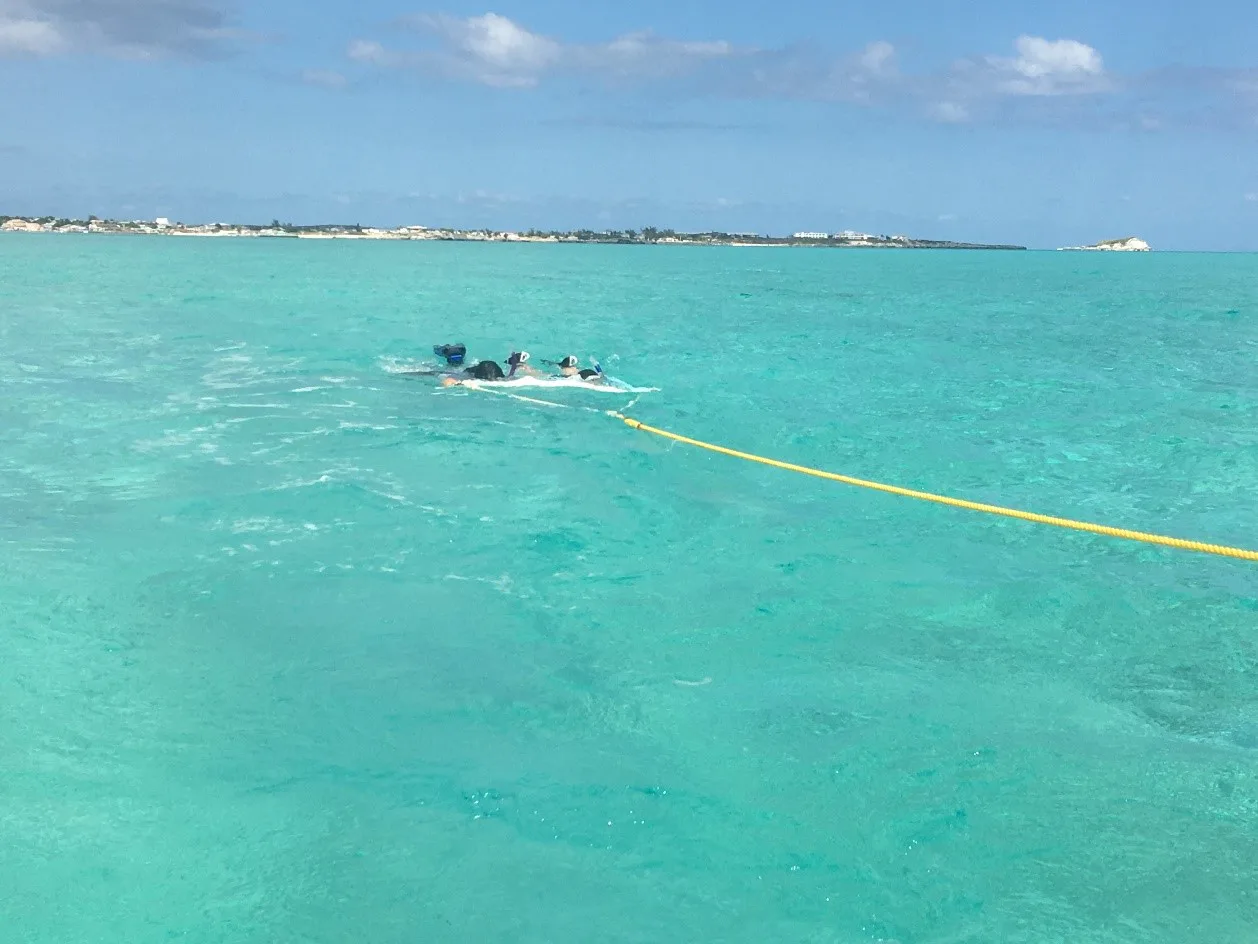
Conch team members, Violeta Keifer and Rachel McLellan, manta towing behind the boat looking for experiment sites
The cultural ecosystem services team is off to a strong start, investigating the ‘services’ South Caicos residents receive from the environment through cultural and spiritual practices and connections. The data collected by this team will contribute to the TCI Natural Capital Accounting (NCA) project I mentioned earlier. Currently, there is no data on the cultural services the environment provides to TCI residents, so these students are filling one of the missing pieces of the NCA project, as well as developing a pilot study that can then be carried out on the other islands in the TCI. Kerry Dunn, one of the team members, expressed that “it is very refreshing to meet community members in a more personal way”, rather than just in passing around town.
Related Posts


